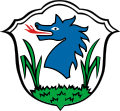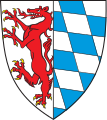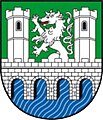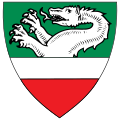Panther (heraldic animal)
The heraldic panther is a fire-breathing, usually slender mythical creature in heraldic art . It has nothing in common with the natural panther (black leopard or jaguar ). He's a mean character .
Design and Blazon

Actually is the essence Pantier (Panthier) , other names are leopard and Pantel , even Panther animal . It originally comes from the Physiologus , an early Christian compendium of animal symbolism, and symbolizes "strong and unbeatable Christianity" in the European heraldic tradition.
In Italian heraldry it is called la dolce , which means 'the sweetness', because of the legendary “fragrant sweet breath”.
“ Panthera: The panther sleeps three days when it has satiated itself. Then he wakes up and raises his voice, while at the same time an extremely delicious fragrance emanates from his mouth. And all animals from near and far follow his voice and fragrance and gather around him. Only the dragon, who is his enemy, fears and hides. So on the third day Christ rose from death and gathered around him those who were near and far, that is, Jews and Gentiles. But the dragon is the devil he overcame. "
The symbolism is therefore quite peaceful and appeals to a mission more of the word than the sword. Since it is widespread in the Bavarian-Austrian area, a connection with the Franconian Bavarian Bavarians - mainly influenced by Irish - and then Bavarian Slavic mission of the 7th to 10th centuries is assumed.
The heraldic panther is usually depicted as an animal with the lower body of a lion , eagle claws on its feet and a horned dragon head , and a horse's head is not uncommon either. But he is always fire-breathing, the depiction of the Odem as a flame is iconographically close to the early depiction of the Holy Spirit . Sometimes the fire also strikes from all orifices.
use
In the Styrian space his performance is popular - there as Styrian Panther silver on green field. It is also common in Bavaria , for example blue in silver in the Upper Bavaria region (for the Counts of Ortenburg , a Spanheim sideline), or red in silver for Lower Bavaria .
Coat of arms of Styria
Coat of arms of the Free State of Bavaria (in the third field)
District of Passau : Wolf and Panther
Coat of arms with the panther
- silver in green: Styrian panther
- blue in silver: Ortenburg
See also
Web links
- State coat of arms of Styria (The Coat of Arms of Styria). In: Europaserver Steiermark> About Styria> Landeswappen. State of Styria, accessed on May 2, 2009 (With a treatise on the heraldic panther and the Physiologus).
Evidence and Notes
- Václav Vok Filip: Introduction to Heraldry . Franz Steiner Verlag, Stuttgart 2000, p. OA
- ↑ a b In the state coat of arms of Styria, this has disappeared as immoral, but the city of Graz has courageously chosen the original representation, that is, striking flames from the genitals and anus.
- ↑ a b Gert Oswald : Lexicon of Heraldry. VEB Bibliographisches Institut, Leipzig 1984.
- ↑ For example: Otto Posse: The seals of the German emperors and kings . Wilhelm and Bertha v. Baensch Foundation, Dresden 1913, supplement: Wapen and Titeln Sr. Kaiserl. Royal Apostol. Majest. Leopold des Zweyten, elected Roman Emperor, King in Germania, Hungary and Boheim, Archduke of Austria, etc. together with their heraldic description. Vienna 1790. Section Heraldic Description of the Great Kaiserl. Royal Archduke Heraldic shield or seal. , S. 246 , col. 2 ( Wikisource ).
- ^ Distichon to the Landeshandfeste, 1523. Quoted from Weblink Styria
- ↑ The Greek Physiologus ( Memento from September 24, 2014 in the Internet Archive )
- ↑ "The panther in this form is a mythical creature with a horse's head, lion's mane, lion's tail, tightly beefed hind legs, short bull horns and claws that spit fire out of its mouth." Quoted from Weblink Styria
















